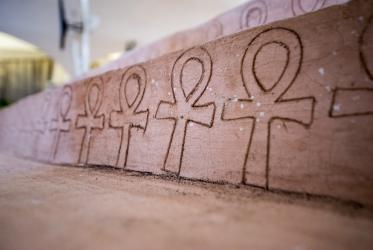Meeting at the Château de Bossey, near Geneva, a Nicaea 2025 steering group of theologians from different regions and church traditions gathered from 9–13 October to develop plans for the world conference, which will likely take place in the third quarter of 2025.
Organized by the WCC Commission on Faith and Order, the conference is planned to gather around the theme “Where now for visible unity?”with a focus on the issues of faith, unity, and mission.
The world conference will gather church leaders and theologians of different traditions and is intended to reaffirm the WCC’s commitment to assisting the churches as they call one another to visible unity and advancing the unity of humanity and of all creation.
“The dividedness of the world, the world in deep conflict and war, is a scandal,” said the moderator of the Faith and Order commission, Rev. Prof. Dr Stephanie Dietrich, opening the steering group meeting. “And so is the disunity of the Christian church,” continued Dietrich, from the Church of Norway.
The First Ecumenical Council was a gathering of Christian bishops in Nicaea, now İznik in present-day Türkiye, as the first attempt to reach consensus in the church through an assembly representing all of Christendom.
This was a “defining moment for the church,” said the moderator of the Nicaea 2025 steering group, the Rev. Prof. Dr Sandra Beardsall, from the United Church of Canada, in her introductory address to the meeting. “It was a moment that even the most hopeful Christian could not have imagined two decades before.”
In Nicaea, Christians who only recently had seen their books burned, buildings looted, and leaders imprisoned, tortured, and martyred, were now able to gather under the patronage of the Emperor to define their faith and witness to the society around them.
The Council of Nicaea led to the Nicene Creed, which begins “We believe in one God,” and is recited by Christians from many different church traditions. It also set a common date for churches to celebrate Easter, although over time Eastern and Western Christianity now use different calendars to calculate the date of Easter, and their celebrations do not usually coincide.
At Bossey, the steering group was addressed by WCC general secretary Rev. Prof. Dr Jerry Pillay.
He noted that alongside the world conference, events marking in the Nicaea anniversary in 2025 would include the Week of Prayer for Christian Unity (marked 18–25 January 2025 in the northern hemisphere) with a focus on the Nicene Creed. The year 2025 is also one of the years in which Eastern and Western churches will celebrate Easter on the same date (20 April).
Members of the steering group offered reflections intended to deepen the consideration of the world conference theme. Topics included apostolic faith in the context of world Christianity, the common celebration of Easter, the contemporary relevance of the Nicene faith, models of church unity, conciliarity and synodality, the triune love of god as a missiological blueprint, the relationship between churches and imperial powers, and the question of the role of women and Nicaea.
“The Nicene faith remains the foundation of our Christian life, uniting Christians to this day,” said Dr Andrej Jeftić, director of Faith and Order. “Therefore, it makes sense that we take Nicaea as the starting point in reflecting on our quest for visible unity today."
World conferences on Faith and Order have been held at key moments in the history of the ecumenical movement. The first such conference was held in 1927 in Lausanne, Switzerland, and the Faith and Order movement was one of the streams that lead to the creation of the WCC in 1948. The most recent conference was in 1993 at Santiago de Compostela in Spain.






